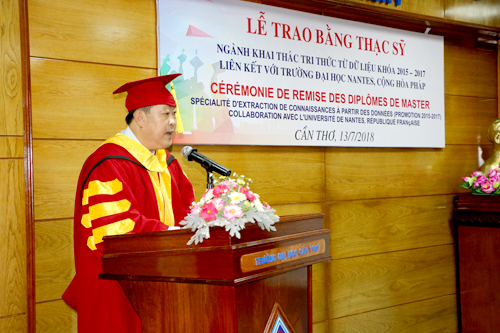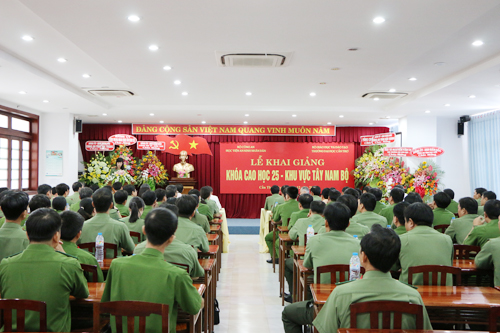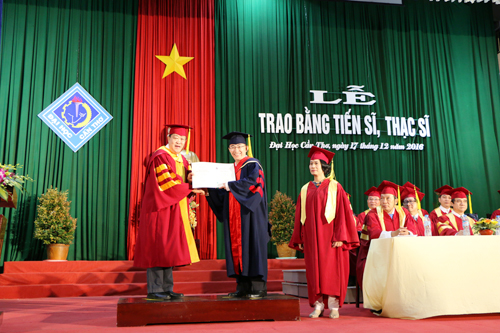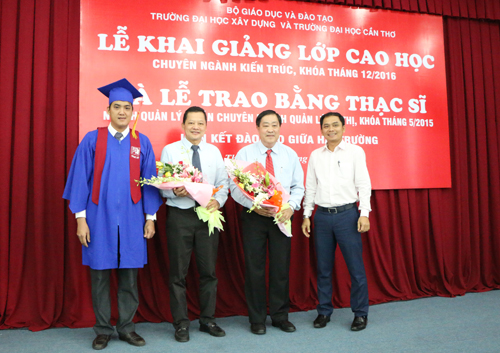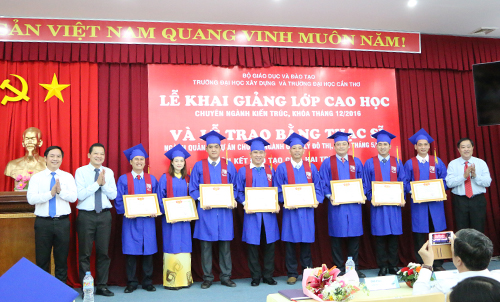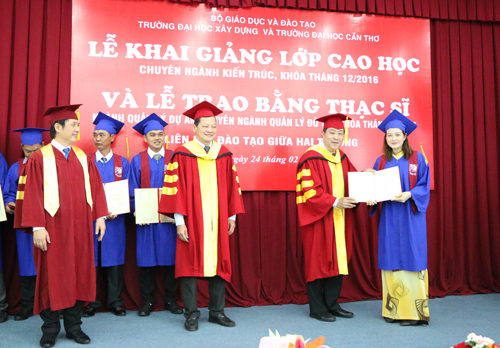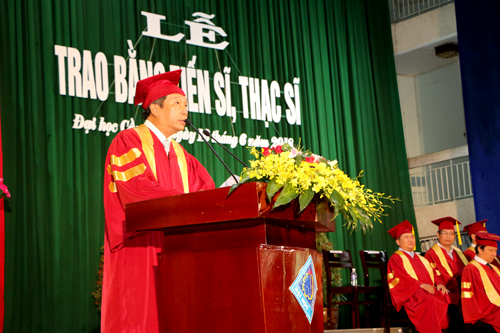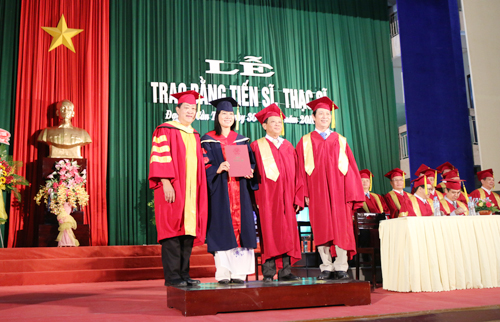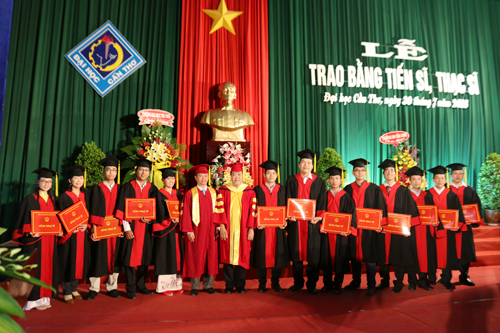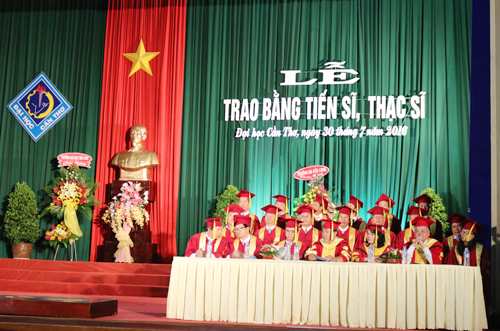
Tên đề tài: Sử dụng chế phẩm protease trong xử lý cám gạo dùng cho chế biến thức uống dinh dưỡng
Tác giả: Lê Hoàng Phượng, Khóa: 2016
Chuyên ngành: Công nghệ thực phẩm; Mã số: 62540101. Nhóm ngành: Công nghệ sản xuất và chế biến
Người hướng dẫn chính: PGS.TS. Lý Nguyễn Bình - Trường Đại học Cần Thơ
- Tóm tắt nội dung luận án
Cám gạo là một nguồn phụ phẩm dồi dào và chứa hàm lượng dinh dưỡng cao. Trong nghiên cứu này hai chế phẩm protease thương mại được sử dụng để vô hoạt enzyme lipase trong cám gạo.
Kết quả nghiên cứu cho thấy khi sử dụng chế phẩm Flavourzyme và Protamex, lipase bị vô hoạt. Quá trình vô hoạt hiệu quả khi kết hợp Flavourzyme và Protamex với tỷ lệ enzyme sử dụng là 0,4% cho mỗi loại, xử lý ở nhiệt độ 50oC và đặc biệt thời gian vô hoạt rút ngắn còn 2 giờ. Sau khi vô hoạt lipase, dịch cám gạo được xử lý nhiệt (tiệt trùng), theo dõi sự thay đổi của thành phần các hợp chất bay hơi trong thời gian bảo quản. Bên cạnh đó, chất xơ prebiotic là fructooligosaccharides (FOS) được xác định có mặt trong cám gạo và chịu ảnh hưởng của các điều kiện chế biến. Kết quả xác định độ bền nhiệt của FOS trong điều kiện pH và nhiệt độ khác nhau cho thấy sự phân hủy của FOS (bao gồm 1-kestose (GF2), nystose (GF3) và 1-fructosyl-nystose (GF4)) trích ly từ cám gạo theo thời gian xử lý nhiệt ở các giá trị pH 5,0, 6,0 và 7,0 tuân theo mô hình động học bậc một. Các giá trị hằng số tốc độ phân hủy nhiệt (k) của GF2, GF3 và GF4 tăng khi nhiệt độ xử lý tăng. Hằng số tốc độ phân hủy k của GF2, GF3 và GF4 có giá càng nhỏ khi pH của mẫu cám gạo có giá trị càng lớn trong khoảng từ 5,0 đến 7,0. FOS của cám gạo rất bền nhiệt ở vùng pH trung tính, trong khi nhạy cảm ở vùng pH acid. Sự phụ thuộc nhiệt độ của các hằng số tốc độ phân hủy nhiệt k của GF2, GF3 và GF4 trong khoảng nhiệt độ khảo sát có thể được mô tả đầy đủ bằng phương trình Arrhenius. Năng lượng hoạt hóa (Ea) trong khoảng pH từ 5,0 đến 7,0 tương ứng với GF2 tăng từ 61,80 đến 77,67 kJ/mol, GF3 từ 67,46 đến 92,31 kJ/mol và GF4 từ 49,24 đến 72,06 kJ/mol. Cám gạo sau khi vô hoạt lipase bằng Flavourzyme và Protamex được sử dụng chế biến sữa chua và bột dinh dưỡng. Chất lượng cảm quan của các sản phẩm được đánh giá ở mức tốt và thời gian bảo quản của bột dinh dưỡng là 2 tháng. Kết quả ban đầu này là nguồn dẫn liệu khoa học có giá trị về định hướng phát triển và khai thác nguồn phụ phẩm nông nghiệp trong tương lai.
Toàn luận án được thực hiện trong bốn nội dung:
Nội dung thứ nhất: nghiên cứu ảnh hưởng của một số yếu tố đến khả năng vô hoạt enzyme lipase trong cám gạo bằng các chế phẩm Protamex và Flavourzyme. Những yếu tố dung môi, nhiệt độ, tỷ lệ enzyme và thời gian thủy phân của chế phẩm protease ảnh hưởng trực tiếp đến hiệu quả vô hoạt enzyme lipase trong cám gạo. Trong nội dung này, kết quả thí nghiệm đã chỉ ra hiệu quả thủy phân khi kết hợp hai chế phẩm Protamex và Flavourzyme hơn là sử dụng chúng riêng lẻ.
Nội dung thứ hai, nghiên cứu ảnh hưởng của các chế độ tiệt trùng và thời gian bảo quản lên thành phần hợp chất bay hơi của nước cám gạo. Cám gạo sau khi đã vô hoạt enzyme lipase được tiệt trùng ở chế độ nhiệt độ tiệt trùng được chọn là 121,1oC (z bằng 10oC, F bằng 6 phút) nhằm tiêu diệt vi sinh vật mục tiêu là bào tử Clostridium botulinum. Dịch cám gạo sau tiệt trùng được đóng hộp và theo dõi hợp chất bay hơi trong thời gian 3 tháng. So sánh mẫu nước cám tiệt trùng và không tiệt trùng thì mẫu có tiệt trùng ghi nhận nhiều hợp chất bay hơi hơn và những hợp chất này thay đổi theo thời gian bảo quan. Trong thời gian theo dõi, có nhiều hợp chất bay hơi mất đi và cũng có nhiều chất mới được sinh ra.
Nội dung thứ 3 Nghiên cứu động học phân hủy nhiệt của hợp chất fructooligosaccharides (FOS) [1-kestose (GF2), nystose (GF3), và 1-fructosyl-nystose (GF4)] trích ly từ cám gạo. Động học phân huỷ nhiệt của fructooligosaccharides (FOS) trong cám gạo đã khử chất béo được nghiên cứu ở nhiệt độ 90, 100 và 110 ◦C và hòa tan trong đệm ở các giá trị pH 5,0, 6,0 và 7,0 được chuẩn bị cho các xử lý nhiệt. Hàm lượng FOS còn lại (bao gồm 1-kestose (GF2), nystose (GF3) và 1F-fructofuranosylnystose (GF4)) được xác định bằng cách sử dụng sắc ký lỏng (UPLC-ESI-MS/MS). Kết quả cho thấy động học suy giảm nhiệt của GF2, GF3 và GF4 tuân theo mô hình động học bậc nhất. Hằng số tốc độ suy giảm nhiệt (giá trị k) của GF2, GF3 và GF4 ở các giá trị nhiệt độ và pH khác nhau được ước tính bằng cách sử dụng phương trình động học bậc nhất. Kết quả là các giá trị k này giảm dần khi pH của mẫu tăng từ 5,0 đến 7,0. Mô hình Arrhenius được áp dụng để mô tả sự phụ thuộc nhiệt của các giá trị k. Năng lượng hoạt hóa (Ea) được tính toán cho từng trường hợp phân hủy GF2, GF3 và GF4 ở các giá trị pH là 5,0, 6,0 và 7,0. Kết quả cho thấy cám gạo FOS rất bền ở pH trung tính trong khi không bền hơn ở pH axit.
Nội dung thứ 4 Ứng dụng cám gạo đã xử lý vào chế biến thức uống dinh dưỡng.
Dịch cám gạo thủy phân được lọc thô, phần bã (50%) được phối trộn cùng bột kem béo thực vật (40%), bột cacao (10%) hoặc bột matcha (10%) sấy đến độ ẩm 5% được bột cám gạo hỗn hợp. Phần dịch cám thủy phân phối trộn: sữa tươi nguyên liệu (50%) phối chế với 10% sữa đặc có đường, sau đó bổ sung dịch cám gạo thủy phân thay đổi từ 15% đến 35%, còn lại là nước lọc, cố định hàm lượng men cái sử dụng là 0,003% lên men đến pH đạt 4,6. Mẫu sữa chua được chọn là mẫu sử dụng 25% dịch cám gạo bổ sung cho các chỉ tiêu tốt nhất về độ nhớt, khả năng giữ nước và điểm cảm quan.
- Những kết quả mới của luận án
Kết quả nghiên cứu đóng góp cơ sở khoa học cho vấn đề nghiên cứu còn bỏ ngõ, cám gạo. Việc sử dụng kết hợp chế phẩm protease nhằm rút ngắn thời gian và tăng hiệu quả xử lý enzyme lipase đã giúp cho việc thu hồi dịch thủy phân chứa thành phần dinh dưỡng nổi trội, làm gia tăng giá trị của sản phẩm ứng dụng là sữa chua và bột dinh dưỡng, đây là hai sản phẩm mới có tính khả thi khi được chuyển giao sản xuất thực tế. Đồng thời, việc nghiên cứu thành phần fructooligosaccharide (FOS) trong cám gạo là nội dung nổi bật, chưa có công trình nghiên cứu nào đã công bố. Ngoài ra, phương pháp “metabolomics” đã được xem như một công cụ đánh giá chất lượng, quá trình chế biến và tính an toàn của nguyên liệu và sản phẩm cuối cùng đã được sử dụng trong nghiên cứu. Từ đây cho thấy nghiên cứu này là công trình có tính mới về đối tượng và về phương pháp.
- Các ứng dụng/ khả năng ứng dụng trong thực tiễn, các vấn đề cần tiếp tục nghiên cứu
Hiện nay, ở nước ta việc nghiên cứu về phụ phẩm nông nghiệp ít công trình được công bố, do đó, kết quả nghiên cứu về cám gạo đã mang lại một ý nghĩa quan trọng, góp phần vào việc định hướng phát triển ngành lúa gạo, một thế mạnh của Việt nam. Nghiên cứu chỉ ra việc sử dụng kết hợp chế phẩm protease mang lại hiệu quả trong xử lý cám gạo và ứng dụng nguồn nguyên liệu này chế biến ra những sản phẩm dinh dưỡng là một hướng đi mới đầy tiềm năng. Bên cạnh đó, nghiên cứu đã bước đầu khảo sát sự hiện diện cũng như điều kiện chế biến ảnh hưởng đến độ bền nhiệt của thành phần FOS, một prebiotic quan trọng đối với sức khỏe con người. Hơn nữa, đề tài còn có tính hiện đại vì sử dụng kỹ thuật fingerprinting và headspace để truy vết và định lượng các hợp chất tạo hương vị trong quá trình chế biến nhiệt các sản phẩm nước uống từ cám gạo. vì vậy, đề tài có giá trị khoa học, thực tiễn và thời sự cao.
Dịch cám gạo thủy phân được sử dụng chế biến thức uống dinh dưỡng cho người với sản phẩm bột cám gạo dinh dưỡng và sữa chua bổ sung dịch cám gạo. Kết quả ban đầu cho thấy các sản phẩm này đã đáp ứng được về mặt dinh dưỡng dùng cho người, có tính khả thi trong triển khai sản xuất thực tế. Tuy nhiên, cần có những nghiên cứu chuyên sâu để nâng cao chất lượng và đa dạng sản phẩm.
Official thesis title: Protease preparations in rice bran treatment and the application in producing the nutritional drink.
Major: Food Technology Code: 62.54.01.01
Full name: Le Hoang Phuong
Supervisor: Assoc. Prof. Ly Nguyen Binh
Educational institution: Can Tho University
- Summary of the objectives of the thesis:
Rice bran is a rich source of by-products and contains high nutritional content. This study used two commercial protease preparations to inactivate the lipase enzyme in rice bran.
Research results show that when using Flavourzyme and Protamex, lipase is inactivated. The inactivation process is effective when combining Flavorzyme and Protamex with a concentration of 0.4% for each enzyme, and the optimum temperature is at 50oC; as a result, the inactivation time is shortened to 2 hours. After lipase inactivation, rice bran juice is heat treated (sterilized), and the observation was carried out to evaluate changes in volatile compounds composition during storage. In addition, prebiotic fiber, fructooligosaccharides (FOS), was determined to be present in rice bran and influenced by processing conditions. The results of determining the thermal stability of FOS under different pH and temperature conditions showed the degradation of FOS (including 1-kestose (GF2), nystose (GF3) and 1-fructosyl-nystose (GF4)) isolated from rice bran by heat treatment time at pH values of 5.0, 6.0 and 7.0 according to first-order kinetic model. The thermal decomposition rate constant (k) values of GF2, GF3 and GF4, increased with increasing treatment temperature. The degradation rate constant k of GF2, GF3 and GF4 gets smaller as the pH of the rice bran sample has a higher value between 5.0 and 7.0. The FOS of rice bran is heat-stable in the neutral pH while sensitive in the acidic pH. The temperature dependence of the thermal decomposition rate constants k of GF2, GF3 and GF4 in the investigated temperature range can be fully described by the Arrhenius equation. The energy activation (Ea) in the pH range from 5.0 to 7.0 corresponds to an increase in GF2 from 61.80 to 77.67 kJ/mol, GF3 from 67.46 to 92.31 kJ/mol and GF4 from 49.24 to 72.06 kJ/mol, respectively. Rice bran, after lipase inactivation by Flavorzyme and Protamex is used to process yoghurt and nutritional powder. The sensory quality of the products was assessed as good, and the shelf life of the nutritional powder was two months. This initial result is a valuable source of scientific data on future development orientation and exploitation of agricultural by-products.
The first objective: Study the influence of some factors on inactive enzyme lipase in temptation by Protamex and Flavorzyme preparations. The environmental factors include solvents, temperature, enzyme rate, and hydrolysis time of protease preparations that directly affect the lipase enzyme inactivation efficiency in rice bran processing. In this context, the experimental results showed that the hydrolytic efficiency of the combination of Protamex and Flavorzyme is rather than their use separately.
The second objective: Study the effect of sterilization modes and storage time on the volatile compounds of rice bran beverage. After inactivating the lipase enzyme, rice bran is sterilized at 121.1oC (z equals 10oC, F equals 6 minutes) to kill the target microorganisms, Clostridium botulinum spores. The sterilized rice bran beverage was canned, and changes in volatile compounds were observed for three months. For the sterilized and unsterilized product samples, the sterilized samples showed more volatile compounds, which changed with the storage time. Many volatile compounds were lost during the follow-up period, and released many new substances.
The third objective: Study on thermolysis kinetics of fructooligosaccharides (FOS) [1-kestose (GF2), nystose (GF3), and 1-fructosyl-nystose (GF4)] were extracted from rice bran. The thermal decomposition kinetics of fructooligosaccharides (FOS) in defatted rice bran was conducted at 90, 100 and 110 ◦C and dissolved in buffer at pH values of 5.0, 6.0 and 7, 0 prepared for the heat treatment. The residual FOS content (consisting of 1-kestose (GF2), nystose (GF3) and 1F-fructofuranosylnystose (GF4)) was determined using liquid chromatography (UPLC-ESI-MS/MS). The results show that the thermal degradation kinetics of GF2, GF3 and GF4 follows a first-order kinetic model. The heat loss rate constants (k-values) of GF2, GF3 and GF4 at different pH and temperature values were estimated using a first-order kinetic equation. As a result, these k values gradually decreased as the pH of the sample increased from 5.0 to 7.0. The Arrhenius model is applied to describe the thermal dependence of the k values. The energy activation (Ea) was calculated for each GF2, GF3 and GF4 degradation case at pH values of 5.0, 6.0 and 7.0. The results show that FOS rice bran is stable at neutral pH but not more stable at acidic pH.
The fourth objective: Application of processed rice bran in producing the nutritional drink. Hydrolyzed rice bran solution was coarsely filtered, and the residue (50%) was mixed with vegetable fat cream powder (40%), cocoa powder (10%) or matcha powder (10%). The mixture was dried to 5% moisture content. The hydrolyzed bran liquid is mixed: raw fresh milk (50%) is mixed with 10% sweetened condensed milk, then hydrolyzed rice bran is added from 15% to 35%, and the rest is filtered water. Yeast was used with the fixed content at 0.003% and fermented until pH reached 4.6. The yogurt was selected as the sample using 25% rice bran liquid supplemented with the best parameters of viscosity, water holding capacity and sensory test.
- The new findings of the thesis:
The research results contribute to the scientific basis for the research problem of rice bran that still has been left behind. The combined use of protease preparations shortens the time and increases the lipase enzyme's efficiency. That effect helps recover the hydrolysate liquid, which contains outstanding nutrients and increases the value of the applied product yogurt and nutritional powder. These are two feasible new products that were transferred to reality production. At the same time, studying the fructooligosaccharide (FOS) composition in rice bran is an outstanding content, but no research has been published yet. In addition, the "metabolomics" method has been used to evaluate the quality, processing, and safety of the raw materials and final products used in the study. From here, it can be seen that this study is novel regarding both objects and methods.
- Practical applicability / further research directions, if any:
Currently, there are few published studies on agricultural by-products in our country. Research shows that the combined use of protease preparations is effective in rice bran treatment, and applying this raw material to process nutritional products is a potential new direction. In addition, the study initially investigated the presence and processing conditions affecting the heat stability of FOS, an essential prebiotic for human health. Moreover, the topic is also modern because it uses fingerprinting and headspace techniques to trace and quantify flavor compounds during the heat processing of drinking water products from rice bran. Therefore, the topic has high scientific, practical, and topical value.
Hydrolyzed rice bran liquid processes nutritional drinks for people with nutritious rice bran powder and yogurt with rice bran supplements. Preliminary results show that these products are nutritionally satisfactory for human consumption and are feasible for reality production. However, in-depth research is needed to improve product quality and diversity.
- Xem chi tiết nội dung luận án
- Xem thông tin đăng tải tại Website Bộ giáo dục và Đào tạo. (Nhập tên NCS vào ô tìm kiếm)





